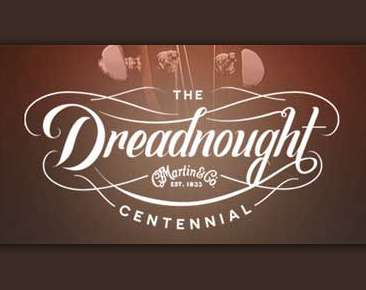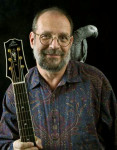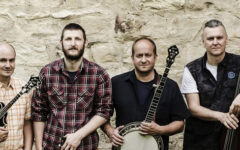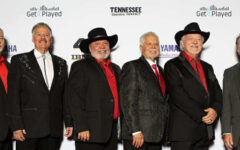
![]() The Martin Dreadnought guitar. It has been said that it has changed the face of popular music.
The Martin Dreadnought guitar. It has been said that it has changed the face of popular music.
Hank Williams had one (the 1941 D-28 now owned by Neil Young), Bill Monroe had one, so did Gene Autry, Doc Watson, Jerry Garcia, John Lennon and Paul McCartney (both using their Martin D-28s to write many of the Beatles’ songs), Elvis Presley (a D-28 also), the Rolling Stones’ Keith Richard, Ramblin’ Jack Elliot, Bob Dylan and Joni Mitchell. And Jimi Hendrix (a 1968 D-45), the Band’s Robbie Robertson was inspired to write the song The Weight by the inscription on his Martin D-28, Pink Floyd’s David Gilmour; Rory Block, widely regarded as the top female interpreter and authority on traditional country blues worldwide, and Jimmy Page.
Then there are current bluegrass notables Del McCoury (his 1956 D-28 gets the most use) and Peter Rowan (a D-18 Golden Era); old and young alike, Seth Avett (a D-35); and Mumford and Sons.
The year 2016 marks a century for the manufacture of the Martin dreadnaught (to use the original spelling for the instrument) guitar. It was actually named after the British Royal Navy battleship, Dreadnought, that was launched in February 1906. The First Sea Lord of the time Sir John Fisher, who lead the development of the new breed of warship, decided that the vessel needed a motto; “Trust in God, and fear naught.” During the 1960s the spelling reference the guitar was corrected.
For the first time a warship was heavily armoured with big guns of the same calibre. The Martins liked to refer to the Dreadnought guitar as The Big Gun.
 The driving force for the design and development of the Martin Dreadnought guitar was Frank Henry Martin, the third generation of Martins to run the business (it is he whose image appears in the poster announcing the mini-documentary, The Ballad Of The Dreadnought).
The driving force for the design and development of the Martin Dreadnought guitar was Frank Henry Martin, the third generation of Martins to run the business (it is he whose image appears in the poster announcing the mini-documentary, The Ballad Of The Dreadnought).
The first Dreadnought built was actually a Model D-222 made for Major Kealakai, the leader of the Royal Hawaiian Sextette.
The first few years were pretty inauspicious for the dreadnought. Originally the emphasis was on its properties as a bass guitar and it didn’t really find its real place in the market until the mid-1930s. At that time the record industry began to use electronic microphones and amplification started to become the norm. Also, guitar players found that they wanted an instrument with greater projection in the larger and/or noisy theaters/bars.
George Gruhn of Gruhn Guitars relates more of the history of the dreadnought guitars in response to some questions ….
What were the structural features of the early Martin Dreadnought guitars?
 “The earliest Martin dreadnought guitars were built on contract by Martin for the Oliver Ditson company with the Ditson logo. They featured a 12 fret slot head neck and extended length 12 fret dreadnought body with sloped shoulders rather than the squared off shape which was introduced early in 1934 and is the most commonly recognized dreadnought shape today. The earliest Ditson dreadnought size guitars featured fan bracing and were marketed primarily for Hawaiian style music. They sold in very small quantities.
“The earliest Martin dreadnought guitars were built on contract by Martin for the Oliver Ditson company with the Ditson logo. They featured a 12 fret slot head neck and extended length 12 fret dreadnought body with sloped shoulders rather than the squared off shape which was introduced early in 1934 and is the most commonly recognized dreadnought shape today. The earliest Ditson dreadnought size guitars featured fan bracing and were marketed primarily for Hawaiian style music. They sold in very small quantities.
![]() During the 1920s Ditson continued to order a very small numbers of dreadnought size guitars and switched from fan bracing to X bracing, but they still remained 12 fret slot head guitars. When Ditson went out of business in 1930 Martin decided to introduce dreadnought guitars under the Martin logo. In 1931 they made a very small number of guitars designated as D-1 and D-2 in which the D-1 was equivalent to a style D-18 and D-2 was equivalent to a style D-28. These guitars were still 12 fret slot head instruments with the long slope shouldered body. Later in 1931 they adopted the names D-18 and D-28. They continued to feature 12 fret necks and the extended length slope shouldered body until early in the year 1934, but some of these early 1934 models with a 12 fret neck and slope shouldered body featured a solid rather than slotted peg-head. By mid-1934 the 14 fret neck with solid peg-head and square shouldered dreadnought was standard for Martin dreadnoughts and has remained so to this day.”
During the 1920s Ditson continued to order a very small numbers of dreadnought size guitars and switched from fan bracing to X bracing, but they still remained 12 fret slot head guitars. When Ditson went out of business in 1930 Martin decided to introduce dreadnought guitars under the Martin logo. In 1931 they made a very small number of guitars designated as D-1 and D-2 in which the D-1 was equivalent to a style D-18 and D-2 was equivalent to a style D-28. These guitars were still 12 fret slot head instruments with the long slope shouldered body. Later in 1931 they adopted the names D-18 and D-28. They continued to feature 12 fret necks and the extended length slope shouldered body until early in the year 1934, but some of these early 1934 models with a 12 fret neck and slope shouldered body featured a solid rather than slotted peg-head. By mid-1934 the 14 fret neck with solid peg-head and square shouldered dreadnought was standard for Martin dreadnoughts and has remained so to this day.”
When did bluegrass guitar players first become interested in playing Martin Dreadnought guitars and in what way was the instrument so suitable for playing bluegrass music?
“Bluegrass music is an invention of Bill Monroe and did not exist as a fully developed musical form until 1945 when Earl Scruggs joined his band. Numerous country music artists were already using dreadnought guitars by that time and Bill owned a late thirties D-28. No other guitars available at that time with the possible exception of the very rare Gibson Advanced Jumbo model produced during the 1930s could equal power and punch of a Martin dreadnought for playing bluegrass rhythm guitar. Martin dreadnoughts were standard equipment for bluegrass players from the earliest conception of this music.”
In what ways have the Martin Dreadnoughts changed through the years and what triggered those changes?
 “The D-28 of mid-1934 looked essentially like a modern dreadnought guitar, but it still had an ebony reinforcement rod in the neck rather than a steel T-bar and had old style bar frets, as did all other Martin guitars. Late in the year 1934 they switched to modern style T frets and had a steel T-bar in the neck. In late 1938 they switched from the so-called forward shifted scalloped bracing to the rear shifted scalloped bracing on the dreadnoughts and other models. During World War II due to metal shortages they switched back to using an ebony bar rather than a steel T-bar. Scalloped bracing was discontinued on the dreadnoughts as well as other Martins in late 1944. Adirondack spruce was replaced with Sitka spruce on the dreadnoughts and other Martins in 1946. Herringbone trim was discontinued on the D-28 after the first work order batch of 1947. These changes in the dreadnoughts over the years are essentially the same as changes in other Martin models over the years. It was not until 1985 that Martin put adjustable truss rods in the necks on any of their guitars. Today there are numerous different dreadnought models in the Martin line, and quality of their new instruments, in my opinion, is very good such that many of the new instruments are better than anything else they have made in the past 50 years.
“The D-28 of mid-1934 looked essentially like a modern dreadnought guitar, but it still had an ebony reinforcement rod in the neck rather than a steel T-bar and had old style bar frets, as did all other Martin guitars. Late in the year 1934 they switched to modern style T frets and had a steel T-bar in the neck. In late 1938 they switched from the so-called forward shifted scalloped bracing to the rear shifted scalloped bracing on the dreadnoughts and other models. During World War II due to metal shortages they switched back to using an ebony bar rather than a steel T-bar. Scalloped bracing was discontinued on the dreadnoughts as well as other Martins in late 1944. Adirondack spruce was replaced with Sitka spruce on the dreadnoughts and other Martins in 1946. Herringbone trim was discontinued on the D-28 after the first work order batch of 1947. These changes in the dreadnoughts over the years are essentially the same as changes in other Martin models over the years. It was not until 1985 that Martin put adjustable truss rods in the necks on any of their guitars. Today there are numerous different dreadnought models in the Martin line, and quality of their new instruments, in my opinion, is very good such that many of the new instruments are better than anything else they have made in the past 50 years.
From 1933 until 1942 the only dreadnoughts in the Martin line were the D-18, D-28, and D-45. The D-45 was discontinued in 1942 and not reissued until 1968. The D-18 model went through similar changes to the D-28 with regard to top wood and bracing. D-18 models featured ebony fingerboards and bridges through 1946 after which they featured rosewood fingerboards and bridges.
From 1943 through 1954 the only Martin dreadnoughts in the line where the D-18 and the D 28. The D-21 was introduced in 1955. 12 string dreadnoughts and the D-35 were introduced in the mid-1960s. The D-41 was introduced in 1969. The HD-28 with herringbone trim and scalloped bracing was introduced in 1976 to meet customer demand, and the D-76 Bicentennial limited-edition model was also introduced in that year. Today Martin makes dozens of different model dreadnought guitars and dreadnought size instruments are the most popular in the Martin line.”
Which Dreadnought model (and age) is the best for bluegrass music and why?
“D-28 Martins, especially those with forward shifted scalloped bracing produced prior to late 1938 are considered to be the ultimate bluegrass guitars along with pre-World War II D-45 guitars, but the fact remains that they made superb quality guitars through the early forties. The D-18 models of the same age are also phenomenal instruments. Martin guitars made during the 1950s are still great guitars. The ones made from the sixties onward are less highly regarded by collectors and are not as powerful sounding as the earlier ones, but if you get the right one, they are still wonderful instruments. Some of the new Martin guitars, especially the ones made as vintage reissue style guitars, are exceedingly good and hold their own very well on stage or in the studio as well as in live performance.”
What are the best alternative makes to the Martin and did the introduction of those lead to changes to Martin Dreadnoughts?
“Gibson made round shouldered dreadnought guitars starting in 1934 which were of good quality, although few bluegrass players equate them with Martin guitars. The Larson brothers of Chicago also made a few dreadnought guitars prior to World War II which are very fine quality, but they are extremely scarce such that I haven’t seen any bluegrass players using one. Today numerous makers produce dreadnought guitars, many of which are of very fine quality such as Collings, Santa Cruz, Huss and Dalton, Bourgeois, Taylor and a whole host of others from major manufacturers down to individual luthiers producing fine handcrafted instruments. Martin continues to be the best known maker of dreadnought guitars and, in my opinion, they remain the pre-eminent American maker of dreadnought guitars to this day.”
Rickey Wasson, for ten years a member of J.D. Crowe’s The New South, has his own particular favourite Martin Dreadnought guitar …..
“For me I like the 1935 D-28s; I think these are the best of the best. The quality of the rosewood and the top wood used at the time makes these guitars very even toned and have the rasp to cut a microphone and every ounce of tone comes out the front of the guitars. I also think the size of the neck adds a lot to the tone of these guitars.
The reason they fit bluegrass so well is banjos are loud and have an edgy tone to them and you must have a guitar with some rasp and gut to be heard playing with these banjos and most of these guitars have it and they also blend well with the banjo.”







